Third in a series

Anyone who has ever read St. John’s gospel probably recalls that the gospel has some beautiful statements about love. What I found so exciting about N.T. Wright’s reflections on love in his book Broken Signposts: How Christianity Makes Sense of the World (HarperOne, 2020, pp. 198, $27.99) is Wright’s insistence that John’s gospel not only contains some beautiful insights into love but that the entire gospel is about love, God’s love for creation and our love for God and other persons.
Reading Wright’s insights into John’s gospel made me feel as though I was seeing what John was about for the first time. I suppose this is why Wright is considered a great scripture scholar and I am not. If I ever needed evidence about Wright’s knowledge of sacred scripture, reading Broken Signposts provided the evidence.
Love, Wright claims, is one of the seven broken signposts that both individuals and cultures desire to have to enlighten their experience. Wright calls them broken because they do not seem to be working. Wright argues convincingly that by deeply reflecting on John’s gospel, we will come to see love in a way that can heal this signpost and motivate us to love more deeply and more unselfishly. I find Wright not only a reliable scholar but also an inspiring writer. Reading Broken Signposts, I had the strong impression that Wright not only spent many hours studying sacred scripture but also many hours praying about what he was studying.
Wright suggests that we read chapter 13 of John’s gospel all the way through to the end of the book as one single, simple act of love, an act of love that costs no less than everything. When I took Wright’s suggestion I could see all the scenes preceding those chapters as acts of love: the encounter with Nicodemus, the meeting with the Samaritan woman at the well, the healings, the feeding of the multitude, the powerful scene of the raising of Lazarus and how that scene points forward toward “the great act of love when Jesus himself is raised from the dead.” (p.41) Wright joins the scenes of love in these chapters to what I like to call “the Cosmic Love Story”:
“What we see going on in the story of Jesus, close up and personal, is what is going on in the much larger, immeasurably larger, cosmic picture. This is how God loves the world, his creation.” (p.41)
In a strikingly beautiful piece of writing, Wright reports John’s cosmic vision of God’s love in the following way:
“It invites us to see the entire drama of creation — the planets, the mountains, the far reaches of cosmic space, the tiniest creature on earth, the refugee, the sick child, the grieving widow, the brittle and arrogant power broker, and the creator God, who made them all, loves them all and grieves over their folly, their wickedness and their sorrow — from this point of view. John wants us to see this whole story as being narrowed down and focused like a bright, blinding laser beam on the single human story of this man, the Word who became flesh — the flesh that reached out and touched the sick, the flesh that was nailed to a Roman cross.”(p. 41-42)
Reading the gospel from chapter 13 to the end as though all the scenes are depicting one single, simple act of love can make the story almost breathtaking. The story of Jesus’ mission is highlighted in a way that the adventurous dimension and the beautiful depth of Jesus’ relationships can shine through all the different scenes. It is no exaggeration to insist that Jesus’ story is the greatest love story ever lived or written. A few weeks ago I followed Wright’s suggestion and read chapter 13 of John’s gospel to the end of the gospel as one single, simple act of love. I plan to read it again that way when I finish writing this column. I will be surprised if I don’t experience the reading at least to some extent as though I was reading it for the first time.
During the pandemic, I resolved to re-read Dostoyevsky’s The Brothers Karamazov, considered by some to be the greatest novel ever written. I had the strange experience of reading sections of the novel as though for the first time. Critics claim that when you return to a masterpiece that you have read previously, the book can speak to you in a new way. You see parts of the story in a new way, appreciate insights in a new way. If this is true of one of Dostoyevsky’s masterpieces, how much more will it be true of John’s gospel, the inspired word of God?
Father Lauder is a philosophy professor at St. John’s University, Jamaica. He presents two 15-minute talks from his lecture series on the Catholic Novel, 10:30 a.m. Monday through Friday on NET-TV.
